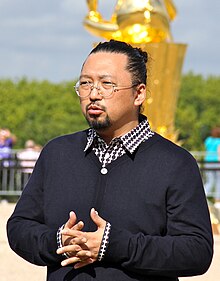/
Takashi Murakami, a prominent Japanese artist with representation in several major cities across the globe, is making big waves on the contemporary art scene. It seems as if he has taken Warhol's factory model and the idea of branding to a new level. Yet it can never be said of Murakami that he isn't present in his artwork. In fact, by American standards, he could most likely be described as overbearing to a degree. His company is called Kaikai Ki Ki Co., Ltd. It is made up of 90 employees in Japan and the United States who work on the direct orders from the artist. The company also represents many other roles of the "company" in modern society:
It makes art. It designs merchandise. It acts as a manager, agent, and producer for seven other Japanese art- ists. It runs an art-fair-cum-festival called Geisai, and it does multimillion-dollar freelance work for fashion, TV, and music companies.
Represented by Blum and Poe of Los Angeles, Gagosian in New York, and Perrotin in Paris, there is no denying the artists international appeal. For one, he understands his place in the world. He says of his work that he is trying to straddle the border between Japanese subculture and art. He draws from his native country's imagery and themes in order to make powerful critical statements about the state of branding and the spectacle in the growing global economy. And, unlike many artists working in the factory mode, he openly acknowledges his labor teams, sometimes even writing their names across the backs of canvases they have helped to create. Murakami is the first to acknowledge the fact that his work would not be possible without their efforts. Admitting that he is not in the business for the money, Murakami wishes to be a prolific artist who creates many things on a grand scale. This is almost impossible work for one man, so he sees his team's vital place as his production crew. Yet he is not one to ever lose sight of his own vision. His assistants and laborers have almost zero creative input. Their work must be totally void of even the evidence of the human hand. For the art's sake, they are necessary simply because Murakami does not possess some of the basic skills which would be necessary to create his large-scale but precise works. For instance, he himself admits to not being able to use the program Adobe Illustrator which allows the images he draws to be expanded without degradation. He hopes that his team will work in the place of a large digital production line. But like a machine, nothing gets done without his consent and every decision comes back to him for the final consultation. The laborers document every layer and part of a painting thoroughly so that Murakami can oversee each small detail even from overseas.
Part of the brilliance of Murakami's practice is his astute awareness of the role of branding, marketing and communications in our society and how to manipulate those systems to his advantage. With work that is aesthetically appealing to a mass market of consumers, Murakami is able to get his stylistic prowess seen on the international markets for fashion, music, and the quotidian. One such effort was a collaboration with Louis Vitton in which he designed a colorful handbag print which would go on to become one of their signature staples. In return, Takashi Murakami has painted several art pieces that include the pattern and flatten the space between the art and the commerce of the physical good. Further, Murakami embarked on a design for the album cover of international pop/rap star Kanye West. Kanye has been a huge success in his own market, and his association with Murakami helps each to cross over into the other's world. Kanye gains a certain amount of respect for his Murakami's cultural significance in the realm of fine art, while Murakami is able to gain recognition for his work from the masses which follow Kanye but might not have otherwise been exposed to his art in the pop culture realm. His paintings and sculptures are infused with what one assistant called "media-world beauty" which makes them marketable and allows them to act as a form of criticism of that same media which disseminates their imagery.
At his solo retrospective in Los Angeles, the show opened alongside a merchandise showroom which sold everything from hats, t-shirts, pens, pencils, and notebooks all emblazoned with Murakami's imagery. This tactic was developed as a marketing scheme, much like the museum bookstore, to attract the general public to take home a small reminder of the artist. The artist is then forever a part of that person's consumerism. Allowing his work to become easily consumed is the next step for Murakami who must surely recognize the desire but inability of the average person to purchase his art.
http://www.takashimurakami.com/
http://www.takashimurakami.com/http://english.kaikaikiki.co.jp/artists/list/C4/
http://english.kaikaikiki.co.jp/artists/list/C4/![]() [http://www.moca.org/murakami/
[http://www.moca.org/murakami/![]() [\|www.moca.org/murakami/|]|]
[\|www.moca.org/murakami/|]|]
\http://www.newyorker.com/arts/critics/artworld/2008/04/14/080414craw_artworld_schjeldahl?currentPage=all




